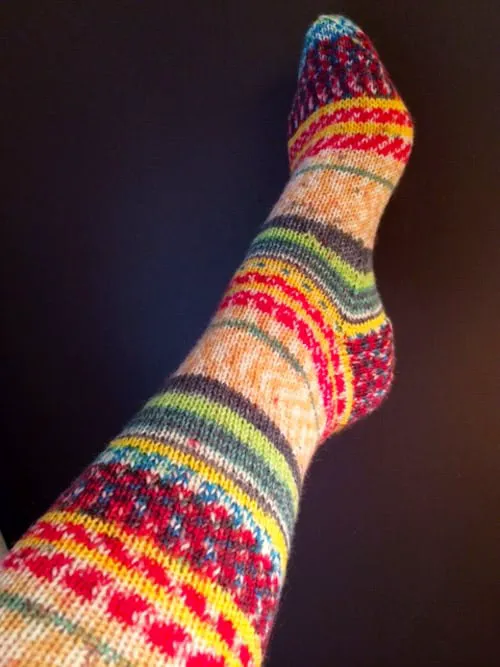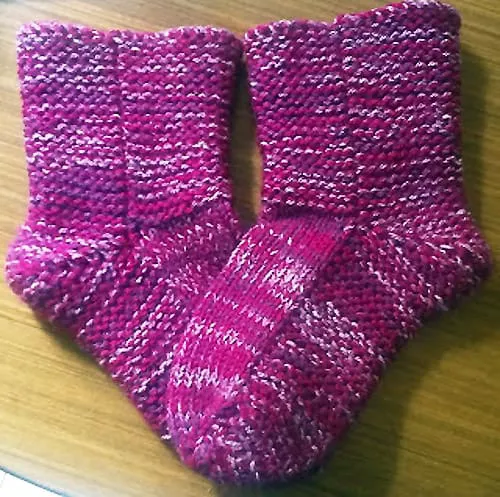Knitting Socks for Beginners: A Step-by-Step Guide
Master the Art of Knitting Socks: A Beginner-Friendly Guide to Creating Cozy Feet
Master the Art of Knitting Socks: A Beginner-Friendly Guide to Creating Cozy Feet
Customise Your Shortie Socks
Want to customise your socks with stripes, color blocks, a different colored heel or toe?
Grab the Simple Shortie Socks PDF pattern, which includes bonus instructions and a video tutorial on how to knit socks with clean color changes and jogless joins.
Abbreviations
DPN(s): Double pointed needle(s)
K: knit
P: purl
P2tog: purl two stitches together
PM: place marker
RS: right side of knitting
Sl: slip the stitch(es)
SSK: slip 1 st, slip 1 st, knit 2 slipped sts together
St(s): stitch(es)
WS: wrong side of knitting
Wyif: with yarn in front
* *: repeat instructions between asterisks the number of times indicated
Knitting socks for beginners
One of the most fun things to knit are socks! They don’t require all that much yarn and are quite useful. Plus, you can’t have too many socks, especially during the cooler months!
That’s why these sock knitting patterns for beginners are perfect for those who are looking to improve their skills and up their knitting game. Socks can be intimidating to knit at first so don't worry! I have a Learn to Knit class that you can watch free for 2 days! Check out the step by step videos here.
Check out our list of sock knitting patterns and start making pairs of these for you and your whole family this winter!
Want to add an additional flare to your socks? I have a Knit Library with 50 Knit Stitches that you can use to customize socks or any other knit pattern! It is a great way to add your personality into your projects. Check out all the stitches here.
Sock Materials
- Yarn: 50 (80, 110, 150, 190, 197) yds / 45 (75, 100, 135, 175, 180) meters of Paintbox Yarns Wool Mix Aran in color 828 (1 ball is 50% wool/50% acrylic; 197yds/180m; 100g/3.5oz)
- set of 7 or 8” 3.75mm DPNs (or needle size to get gauge)
- set of 7 or 8” 3.5mm DPNs (optional for ribbing) – locking stitch marker
- tapestry needle
- scissors
- measuring tape
- locking stitch marker (optional)
Gauge: 23 sts/ 30 rounds = 4” in stockinette stitch in the round on larger double pointed needles
Recommended Sock Yarns: Choose a wool or wool and acrylic blend yarn. Wool provides warmth and stretch while acyrlic provides durability. Avoid 100% acrylic yarns as they don’t have much stretch; acrylic socks tend to grow baggy with wear. Below are some recommended yarns:
- Valley Yarns Northampton (100% wool) (Lovecrafts)
- Valley Yarns Superwash (100% merino wool) (Lovecrafts)
- Sirdar Country Classic Worsted (50% wool/50% acrylic) (Lovecrafts)
Materials and Tools Needed for Knitting Socks
To start knitting socks, you will need the right materials and tools.
The materials you need include a good quality sock yarn, which is a special type of yarn that is durable and stretchy. Choose a good quality yarn made of wool, wool blend, or acrylic for durability and comfort. My personal favorite is a wool blend because it is durable, warm, and can wick away moisture. I usually use Patons Kroy Socks Yarn or Novita 7 Brothers for knitting socks. You can read more about different types of yarn here.
Generally, you will need one skein or 1.75oz (50g) to make one average adult sock. This means 3.5oz (100g) of yarn for a pair of socks.
You will also need a set of 5 double-pointed needles (DPNs). Make sure to choose needles that are the right size for your yarn, as indicated on the yarn label. Usually this means around US size 1 to 4 (2.25 to 3.5mm). If you are a beginner knitter, I recommend going with a bit thicker sock yarn, such as Novita 7 Brothers, and medium-sized needles. I always use US 2 (2.75mm) needles for Patons Kroy Sock Yarn and US 4 (3.5mm) needles for Novita 7 Brothers.
If you are using yarn that is not designed for socks, you should go down one or two needle sizes from what is recommended on the yarn label. The yarn label assumes that you’re making something else than socks and socks will become more durable when they’re knit at a tight gauge.
Other materials you will need include a tape measure for sizing your socks, scissors to cut yarn, and a tapestry needle to weave in the ends.
Finally, you may also opt for sock blockers. They are not a must when knitting socks but they do get your socks that finished look. If you want, you can also make your own sock blockers! Check the instructions for how to make sock blockers here.



Tegs:
Search
Recent Posts
-
Mastering the Yarn Over Technique in Knitting: A Step-by-Step Guide
Apr 14 2025
-
Master the Rectangle Loom: Techniques and Patterns for Beginners
Apr 14 2025
-
Graphic Knitting Patterns: Add a Pop of Art to Your Knitwear
Apr 14 2025
-
Minnesota Knitting Mills: Explore the Legacy of Knitting and Yarn Production in the State
Apr 14 2025
Subscribe to Updates
Get the latest posts and fashion insights directly in your inbox.